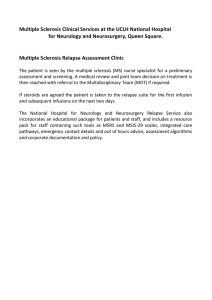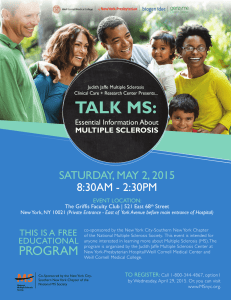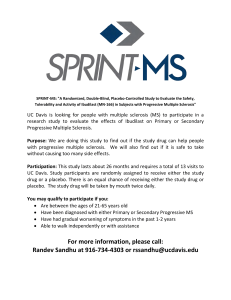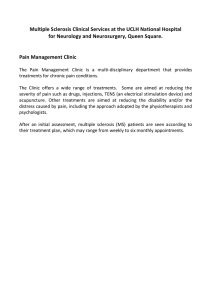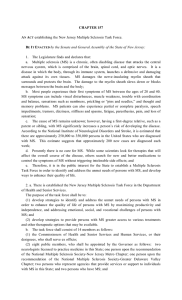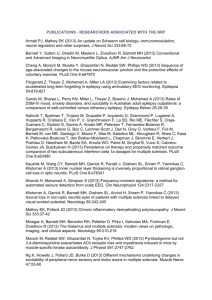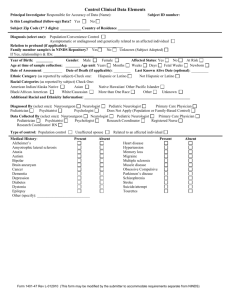Document 13730453
advertisement
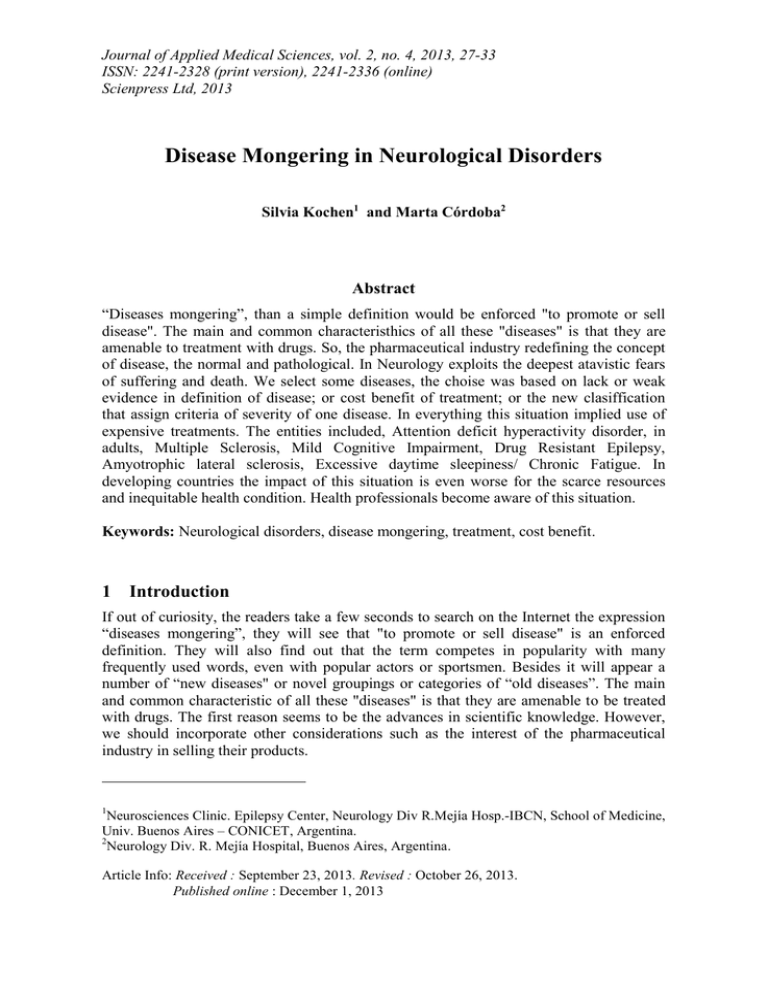
Journal of Applied Medical Sciences, vol. 2, no. 4, 2013, 27-33 ISSN: 2241-2328 (print version), 2241-2336 (online) Scienpress Ltd, 2013 Disease Mongering in Neurological Disorders Silvia Kochen1 and Marta Córdoba2 Abstract “Diseases mongering”, than a simple definition would be enforced "to promote or sell disease". The main and common characteristhics of all these "diseases" is that they are amenable to treatment with drugs. So, the pharmaceutical industry redefining the concept of disease, the normal and pathological. In Neurology exploits the deepest atavistic fears of suffering and death. We select some diseases, the choise was based on lack or weak evidence in definition of disease; or cost benefit of treatment; or the new clasiffication that assign criteria of severity of one disease. In everything this situation implied use of expensive treatments. The entities included, Attention deficit hyperactivity disorder, in adults, Multiple Sclerosis, Mild Cognitive Impairment, Drug Resistant Epilepsy, Amyotrophic lateral sclerosis, Excessive daytime sleepiness/ Chronic Fatigue. In developing countries the impact of this situation is even worse for the scarce resources and inequitable health condition. Health professionals become aware of this situation. Keywords: Neurological disorders, disease mongering, treatment, cost benefit. 1 Introduction If out of curiosity, the readers take a few seconds to search on the Internet the expression “diseases mongering”, they will see that "to promote or sell disease" is an enforced definition. They will also find out that the term competes in popularity with many frequently used words, even with popular actors or sportsmen. Besides it will appear a number of “new diseases" or novel groupings or categories of “old diseases”. The main and common characteristic of all these "diseases" is that they are amenable to be treated with drugs. The first reason seems to be the advances in scientific knowledge. However, we should incorporate other considerations such as the interest of the pharmaceutical industry in selling their products. 1 Neurosciences Clinic. Epilepsy Center, Neurology Div R.Mejía Hosp.-IBCN, School of Medicine, Univ. Buenos Aires – CONICET, Argentina. 2 Neurology Div. R. Mejía Hospital, Buenos Aires, Argentina. Article Info: Received : September 23, 2013. Revised : October 26, 2013. Published online : December 1, 2013 28 Silvia Kochen and Marta Córdoba 2 Preliminary Notes Almost 20 years ago, Lynn Payer [1] used the term “disease mongering” for the first time as the strategy of the pharmaceutical industry to expand the boundaries of treatable illness in order to increase the market (Table 1) [2]. This concept was recently defined as “the selling of sickness that widens the boundaries of illness and grows the markets for those who sell and deliver treatments.” [3] Therefore, the pharmaceutical industry redefines what is normal and what is pathological modifying the concept of disease. Much disease mongering relies on considering normal biological or social variation as pathologies. It also is based on the portrayal of disease risk factors as if it was a pathological state in itself. The vicious circle is completed when pharmaceuticals are used to treat risk factors because “anyone who takes medicines is by definition a patient” [4, 5, 6]. Disease mongering exploits the deepest atavistic fears of suffering and death. In neurology added aspects are related to cognitive function, or illness that cause great disability, high mortality, or are surrounded by stigma. The principal aim of this paper is generate awareness in neurologists about of relatively new situation. We selected some “new diseases” or disease mongering aspects in “old disease” (Table 2). Although this corpus is just a sample, it is useful to remark the effect of disease mongering in neurology field. The choice was based on lack or weak evidence in one or more condition: a- definition of disease; or b- cost benefit analysis of drug treatment; or c- the use of new classification that assign criteria of severity in a disease. In every case, this situation implies the use of expensive treatments. We describe a brief review of each of the entities included. There is an important advertising campaign aimed at potential consumers in order to “improve cognitive functions” in mentally and neurologically healthy people, this statement is very complexe and ambiguous. However, there is a very large offer of drugs. The prescription of modafinil, adrafinil, methylphenidate, inderal, piracetam, aniracetam, amphetamines has increased in the last time [7]. 3 Main Results ATTENTION DEFICIT HYPERACTIVITY DISORDER IN ADULTS PATIENTS (ADHD) National Institute for Health and Clinical Excellence (NICE, 2011) highlights the weak evidence in the definition of this "disease": “this would be best conducted as an epidemiological survey to answer the ADHD in adults”. In 1986, Nasrallah et al. [8] reported brain atrophy in adult males treated with amphetamines during childhood concluding: “since all of the HK/MBD [hyperkinetic/ minimal brain dysfunction] patients had been treated with psychostimulants, cortical atrophy may be a long-term adverse effect of this treatment”. In spite of this research other authors published “Recent investigations with magnetic resonance imaging (MRI) provide converging evidence that a refined phenotype of ADHD is characterized by reduced size of the frontal lobes and basal ganglia “ [9]. However there had been no such studies of ADHD-untreated cohorts [10]. Although ADHD is a recognized pathology (ICD, DSM-IV) in children, we cannot stop thinking that the possibility of a drug treatment can shoot some diagnostics, which does not happen with disorders no treatable with drugs such as dyslexia. ADHD is a symptom, Disease Mongering in Neurological Disorders 29 a syndrome or a disease diagnosed in 7.8% of U.S. children between 4-17 years (4.4 million children), according to results of a parent survey conducted in 2003, of which 56% were medicated at the time. Also in Spain the consumption of methylphenidate fivefold from 1992 to 2001 with an estimated increase in annual consumption of 8%. Could be possible to reduce diagnoses understanding ADHD from a model of mental functioning rather than from a model based on observable behavior and the sum of symptoms, sometimes collected through global questionnaires [5, 11]. In recent studies, in children and in adults, observed increased in the prevalence of this diagnosis with a trend of increasing prescribing of ADHD drug treatment, however no demonstrate more evidence diagnostic [12, 13, 14] EXCESSIVE DAYTIME SLEEPINESS (EDS) AND CHRONIC FATIGUE Both categories EDS and Chronic Fatigue, can be considered together taking into account that there is overlaping on the definition used to define each of them, even their existence as diseases or syndromes is contested [15]. Nevertheless, there is abundant mass media advertising refered to the “good results” achieved with psychostimulants. A recently editorial of Neurology [16], describe in relation a paper published in the same journal [17], as despite having a Class I level of evidence in the treatment protocol with modafinil in EDS and chronic fatigue, detailed analysis showed did not improve fatigue symptoms, nor were there any benefits in the psychomotor vigilance test [18]. MILD COGNITIVE IMPAIRMENT (MCI) Despite there are clinical guides that contemplate mild cognitive impairment as a defined disease [19], their consideration as a clinical entity according to some authors is still a matter of debate. In this context of uncertainty, clinical trials have been developed in the attempt to study the effects of ChEIs (donepezil, rivastigmine, and galantamine) in delaying the conversion from MCI to Alzheimer disease or dementia [20]. Although the use of ChEIs in MCI was not associated thus far, with any delay in the onset of AD or dementia, the safety profile showed that the risks associated with ChEIs were not negligible [21]. However appears information in scientific journals and in mass media that encourages the use of these drugs to "prevent" these dreaded diseases. The disorders that mainly leads to a deterioration of motor skill as multiple sclerosis or fatal disorder such as amyotrophic lateral sclerosis, high influence for patients, healthcare systems, and society as a whole: MULTIPLE SCLEROSIS It is remarkable the profound analysis made by James Raftery [22]. What happened with multiple sclerosis risk sharing scheme in United Kingdom represent a unique situation where the NHS is paying for thousands of patients to receive drugs that monitoring data suggest are not effective. This scheme was set up in 2002 after the National Institute for Health and Clinical Excellence (NICE) recommended against the use of interferon beta and glatiramer acetate. It is based on outcome analysis, not only in cost benefit analysis. There was an agreement that prices would be reduced if patient outcomes were worse than predicted. Disease progression was not only worse than predicted by the model used by NICE [23], but even worse than the untreated control group. In the same way, Cochrane multiple sclerosis group has proposed that the efficacy of interferon on exacerbations and disease progression in patients with relapsing remitting MS was modest after one and two years of treatment. Interferon administered by the oral route was not 30 Silvia Kochen and Marta Córdoba effective for prevention of relapses. Longer follow-up and more uniform reporting of clinical and MRI outcomes among these trials might have allowed for a more convincing conclusion [24, 25]. Recently in a systematic review indicating that the anti-inflammatory effect of Interferon β is unable to prevent MS progression once it has become established [26]. Nevertheless, there was not any price reduction, moreover, in our country the prices are more than double that in developed countries [27]. AMYOTROPHIC LATERAL SCLEROSIS (ALS) Several ALS therapies have shown promising results in preclinical models of motor neuron disease. However, most of them failed in human studies. A remarkable progress in understanding the cellular mechanisms of motor neuron degeneration has not been matched with the development of therapeutic strategies to prevent disease progression or to extend survival longer clinical trials [28]. The current estimations of the cost-effectiveness of riluzole must be analized cautiously. The uncertainty of the benefits in the economic analysis is due to the overconsideration of the survival gain that is experienced in a determined disease stage. The quality of life utility weights upon ALS health states and the gained life expectancy for individuals who take riluzole. Estimates from different trials suggest a gain in median tracheostomy free survival time of 2 months to 4 months [29, 30, 31]. This treatment implies an increase in costs for the health service. In addition to the unsatisfactory results, the great impact of these costs in developing countries is almost impossible to afford. DRUG RESISTANT EPILEPSY Epilepsy is one of the most prevalent neurological disorders that can be effectively prevented and treated at an affordable cost for most of patients. Different epidemiological studies estimated that up to 22.5% of patients with epilepsy have drug-resistant epilepsy. In this group the use of new drugs, more expensive, or nondrug therapy such as epilepsy surgery should be considered [32]. A new definition recently proposed for ILAE (International League against Epilepsy) [33] includes in this category patients that present seizures, opposed to patient seizure- free, without special consideration, i.e. seizures without consciousness, or only during sleep, or one seizure by year. Although before to mentioned definition, there was no unified definition of drug resistant epilepsy, those patients who had affected their quality of life were included as drug resistant or refractory epilepsy. Numerous of patients now included in this group, were not consider in this category previous to recent definition [34]. It is evident that in this new classification the concept quality adjusted life year (cost/QALY) is not considered, and allows that many more patients are liable to receive more expensive and sophisticated treatments. 31 Disease Mongering in Neurological Disorders 4 Labels of Figures and Tables Table 1: Mogering Disease Definition Taking a normal function and implying that there is something wrong with it and should be treated To attribute the suffering of a disease where there is not necessarily an actual illness Increase the ranges of diseases prevalence Define a health condition as "absence of disease" Select the use of statistics to exaggerate the benefits of treatment Take a common symptom that can mean anything and make it sound like a symptom of a serious illness Promote anxiety or fear that healthy people get sick in the future Promote aggressive treatment with pharmaceuticals for minor illnesses or symptoms Entering new questionable diagnoses, that are difficult to distinguish from normal life Promotion of pharmaceuticals as first-line solutions for problems not previously considered as medical problems From Payer, Lynn “DISEASE” Table 2: Disease Mongering In Neurology CONDITION Attention deficit hyperactivity disorder in adults patients Definition of disease (ADHD) Multiple Sclerosis Cost benefit analysis of drug treatment Excessive daytime sleepiness (EDS) / Chronic Fatigue Definition of disease Drug Resistant Epilepsy New criteria of clasiffication Amyotrophic lateral sclerosis (ALS) Cost benefit analysis of drug treatment Definition of disease Mild Cognitive Impairment (MCI) 5 Conclusion Pharmaceutical companies are not the only actors in this field. Physicians, patients, mass media, politicians, also play a role with different contributions, but together multiply the effect of disease mongering. There must be awareness of all stakeholders to know this problem at the moment of making decisions related with diagnosis and prescription. It is necessary the implementation issues in latinoamerica as the “Sunshine Act”, part of the Affordable Care Act, created in USA, requires manufacturers to submit a list of physicians and teaching hospitals who received from them a transfer of value, but neither was implemented even in the country of origin. We consider it is essential that health professionals become aware of this relatively new 32 Silvia Kochen and Marta Córdoba condition, which increases more and more, probably have even more serious impact on developing countries for their limited resources and inequitable health condition. References [1] [2] [3] [4] [5] [6] [7] [8] [9] [10] [11] [12] [13] [14] [15] [16] [17] [18] Payer, Lynn “Disease-Mongers: How Doctors, Drug Companies, and Insurers are Making You Feel Sick” Wiley, USA, 1994. Andresik D., " Disease Mongering: El arte de fabricar enfermedades”, Biophronesis, Revista de Bioética y Socioantropologia en Medicina, 2009, 4(2)" Jairaj Kumar C., Abhizith D., Ashwini K., Arunachalam K., Hegde B. M., “Awareness and Attitudes about Disease Mongering among Medical and Pharmaceutical Students”, April 2006, 3(4) ,e210, PLoS Medicine, published by the US Public Library of Science (PLoS). Rose G (1985) Sick individuals and sick populations. Int J Epidemiol 14: 32–38. Moynihan R. Cassels A. Selling sickness, Vancouver: Greystone Books, 2005. ISBN 1553651316 Cuestas E. The new strategies for disease mongering; Rev Fac Cien Med Univ Nac Cordoba. 2011; 68(3):89-93. Gilbert D, Walley T, New B. Lifestyle medicines. BMJ. 2000; 321:1341 Nasrallah HA, Loney J, Olson SC, McCalley-Whitters M, Kramer J, et al. (1986) Cortical atrophy in young adults with a history of hyperactivity in childhood. Psychiatry Res 17: 241–246 Swanson J, Castellanos FX (1998) Biological bases of attention deficit hyperactivity disorder. Program and Abstracts, NIH Consensus Development Conference on Attention Deficit Hyperactivity Disorder; 16–18 November 1998; Bethesda, Maryland. pp. 37–42. Baughman FA (1999) ADHD—Total, 100% fraud [video]. Produced from the official video of the NIH Consensus Development Conference on Attention Deficit Hyperactivity Disorder; 16–18 November 1998; Bethesda, Maryland. Sixto ME., Martínez González C., Quintana Gómez JL., “Disease mongering, el lucrativo negocio de la promoción de enfermedades”. Rev Pediatr Aten Primaria. 2009; 11:491-512 Doshi JA, Hodgkins P, Kahle J, Sikirica V, Cangelosi MJ, Setyawan J, Erder MH, Neumann PJ. Economic impact of childhood and adult attention-deficit/hyperactivity disorder in the United States. J Am Acad Child Adolesc Psychiatry. 2012 Oct; 51(10):990-1002. Barry CL, Martin A, Busch SH. ADHD medication use following FDA risk warnings. J Ment Health Policy Econ. 2012 Sep; 15(3):119-25. Batstra L, Frances A. DSM-5 further inflates attention deficit hyperactivity disorder. J Nerv Ment Dis. 2012 Jun; 200(6):486-8. Holgate ST, Komaroff AL, Mangan D, Wessely S. Chronic fatigue syndrome: understanding a complex illness. Nat Rev Neurosci. 2011 Jul 27; 12(9):539-44. Richard M. Dasheiff, Editorial Neurology, Modafinil is not the new caffeine Richard M. Dasheiff. Neurology 2010; 75:1764–1765 Kaiser PR, Valko PO, Werth E, et al. Modafinil ameliorates excessive daytime sleepiness after traumatic brain injury. Neurology 2010; 75:1780 –1785. Kesselheim AS, Myers JA, Solomon DH, Winkelmayer WC, Levin R, Avorn J. The Disease Mongering in Neurological Disorders [19] [20] [21] [22] [23] [24] [25] [26] [27] [28] [29] [30] [31] [32] [33] [34] 33 prevalence and cost of unapproved uses of top-selling orphan drugs. PLoS One. 2012;7(2):e31894 The NICE guideline on supporting people with dementia and their carers in health and social care this clinical guideline has been amended to incorporate the updated nice technology appraisal of drugs for alzheimer’s disease, published in march 2011 (www.nice.org.uk/guidance/ta217). Gauthier S., Touchon J., “Mild cognitive impairment is not a clinical entity and should not be treated”. Arch Neurol 62: 1164–1166. 2005 Raschetti R., Albanese E., Vanacore N., Maggini M., “Cholinesterase inhibitors in mild cognitive impairment: A systematic review of randomised trials”. PLoS Med 4(11): e338. doi:10.1371/journal. pmed.0040338. 2007 Raftery James. Multiple Sclerosis risk sharing scheme: a costly failure. BMJ 2010; 340:c1672 NICE. Multiple Sclerosis-beta interferon and glatiramer acetate. Technology appraisal 32.2002 G Rice, B Incorvaia, L Munari, G Ebers, et al. Interferon in relapsing-remitting multiple sclerosis. Editorial Group: Cochrane Multiple Sclerosis Group. Published Online: 21 JAN 2009, The Cochrane Collaboration. Published by John Wiley & Sons, Ltd. Noyes K, Bajorska A, Chappel A, Schwid SR, Mehta LR, Weinstock-Guttman B, Holloway RG, Dick AW. Cost-effectiveness of disease-modifying therapy for multiple sclerosis: a population-based study. Neurology. 2011 Jul 26;77(4):355-63. La Mantia L, Vacchi L, Rovaris M, Di Pietrantonj C, Ebers G, Fredrikson S, Filippini G.J Interferon β for secondary progressive multiple sclerosis: a systematic review. Neurol Neurosurg Psychiatry. 2012 Sep 5. [Epub ahead of print] De Robles P., Recchia L., Gonorasky S. , Gonzalez Aguilar P. El costo derivado del número necesario a tratar. Revista Neurológica Argentina 2006; 31: 59-64 A Pratt, E Getzoff, J Perry, Amyotrophic lateral sclerosis: update and new developments. Degener Neurol Neuromuscul Dis. 2012 February; 2012(2): 1–14. Ludolph A. and Jesse S. “Evidence-based drug treatment in amyotrophic lateral sclerosis and upcoming clinical trials” Ther Adv Neurol Disord (2009) 2(5) 319–326 Guidance on the Use of Riluzole (Rilutek) for the Treatment of Motor Neurone Disease Published by the National Institute for Clinical Excellence January 2001. Miller RG, Mitchell JD, Moore DH. Riluzole for amyotrophic lateral sclerosis (ALS)/motor neuron disease (MND) Cochrane Database Syst Rev. 2012. Shorvon SD. Epilepsia. 1996; 37 Suppl 2:S1-S3. Review. Kwan P., Arzimanoglou A., Berg A., Brodie M., Hauser W., Mathern G., Moshé S., Perucca E. , Wiebe S., French J.; “Definition of drug resistant epilepsy: Consensus proposal by the ad hoc Task Force of the ILAE Commission on Therapeutic Strategies” ; Epilepsia 51(6), pages 1069–1077, June 2010. B Westover, J Cormier, M Bianchi, M Shafi, R Kilbride, A Cole, S Cash. Revising the ‘‘Rule of Three ’’ for inferring seizure freedom ; Epilepsia, 53(2):368–376, 2012.
